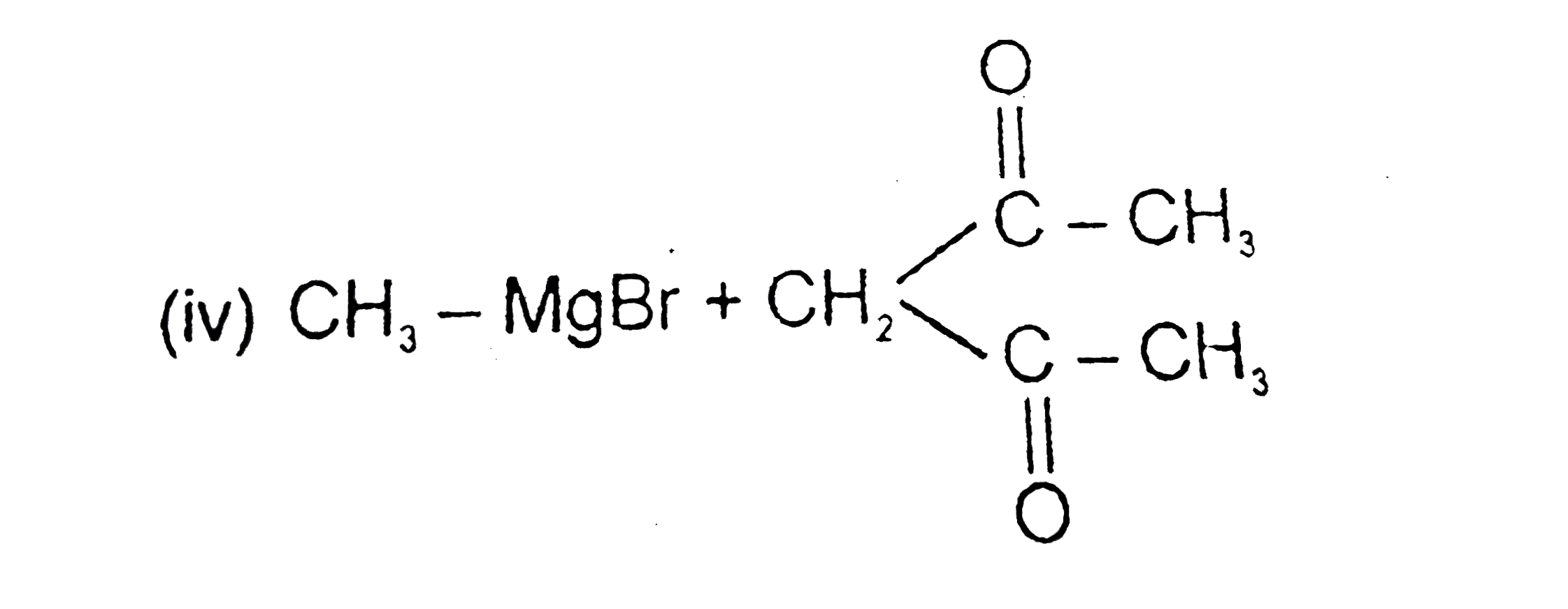Which of the following reaction(s) can be used for the preparation of alkyl halides?
(I) CH3CH2OH+HClanhy.ZnCl2−−−−−−−→
(II) CH3CH2OH+HCl→
(III) (CH3)3COH+HCl→
(IV) (CH3)2CHOH+HClanhy.ZnCl2−−−−−−−→
(IV ) only
(III) and (IV) only
(I), (III) and (IV) only
(I), and (II) only
The correct Answer is:C
To determine which of the given reactions can be used for the preparation of alkyl halides, we need to analyze each reaction based on the type of alcohol and the conditions provided.
1. Reaction I: CH₃CH₂OH+HCl(anhy.ZnCl₂)→
- This is a primary alcohol (ethanol) reacting with HCl in the presence of anhydrous ZnCl₂.
- The presence of ZnCl₂ helps in the cleavage of the carbon-oxygen bond, facilitating the formation of a carbocation which can then react with Cl⁻ to form ethyl chloride (alkyl halide).
- Conclusion: This reaction can be used to prepare an alkyl halide.
2. Reaction II: CH₃CH₂OH+HCl→
- This is the same primary alcohol (ethanol) reacting with HCl but without the presence of ZnCl₂.
- While HCl can react with alcohols, the absence of ZnCl₂ means that the reaction is less efficient and may not lead to significant alkyl halide formation.
- Conclusion: This reaction is not reliable for preparing alkyl halides.
3. Reaction III: (CH₃)₃COH+HCl→
- This is a tertiary alcohol (tert-butanol) reacting with HCl.
- Tertiary alcohols can react directly with concentrated HCl to form alkyl halides without the need for ZnCl₂.
- Conclusion: This reaction can be used to prepare an alkyl halide.
4. Reaction IV: (CH₃)₂CHOH+HCl(anhy.ZnCl₂)→
- This is a secondary alcohol (isopropanol) reacting with HCl in the presence of anhydrous ZnCl₂.
- Similar to the primary alcohol, the presence of ZnCl₂ facilitates the reaction, allowing the formation of isopropyl chloride (alkyl halide).
- Conclusion: This reaction can also be used to prepare an alkyl halide.
Final Conclusion:
The reactions that can be used for the preparation of alkyl halides are:
- Reaction I
- Reaction III
- Reaction IV
Thus, the correct answer is Reaction I, Reaction III, and Reaction IV.
- This is a primary alcohol (ethanol) reacting with HCl in the presence of anhydrous ZnCl₂.
- The presence of ZnCl₂ helps in the cleavage of the carbon-oxygen bond, facilitating the formation of a carbocation which can then react with Cl⁻ to form ethyl chloride (alkyl halide).
- Conclusion: This reaction can be used to prepare an alkyl halide.
- This is the same primary alcohol (ethanol) reacting with HCl but without the presence of ZnCl₂.
- While HCl can react with alcohols, the absence of ZnCl₂ means that the reaction is less efficient and may not lead to significant alkyl halide formation.
- Conclusion: This reaction is not reliable for preparing alkyl halides.
- This is a tertiary alcohol (tert-butanol) reacting with HCl.
- Tertiary alcohols can react directly with concentrated HCl to form alkyl halides without the need for ZnCl₂.
- Conclusion: This reaction can be used to prepare an alkyl halide.
- This is a secondary alcohol (isopropanol) reacting with HCl in the presence of anhydrous ZnCl₂.
- Similar to the primary alcohol, the presence of ZnCl₂ facilitates the reaction, allowing the formation of isopropyl chloride (alkyl halide).
- Conclusion: This reaction can also be used to prepare an alkyl halide.
The reactions that can be used for the preparation of alkyl halides are:
- Reaction I
- Reaction III
- Reaction IV
Topper's Solved these Questions
- ALCOHOLS, PHENOLS AND ETHERSBOOK - AAKASH INSTITUTE ENGLISHCHAPTER - ALCOHOLS, PHENOLS AND ETHERSEXERCISE - Assignment Section - C (Questions asked Prior to medical Ent. Exams. 2005)
13 Videos
- ALCOHOLS, PHENOLS AND ETHERSBOOK - AAKASH INSTITUTE ENGLISHCHAPTER - ALCOHOLS, PHENOLS AND ETHERSEXERCISE - Assignment Section -D (Assertion - reason type question)
20 Videos
- ALCOHOLS, PHENOLS AND ETHERSBOOK - AAKASH INSTITUTE ENGLISHCHAPTER - ALCOHOLS, PHENOLS AND ETHERSEXERCISE - Assignment Section - B (Objective type questions)
25 Videos
- ALCOHOLS, PHENOLS AND ETHERS BOOK - AAKASH INSTITUTE ENGLISHCHAPTER - ALCOHOLS, PHENOLS AND ETHERS EXERCISE - Try Yourself
5 Videos
Similar Questions
Knowledge Check
Which of the following is the proper method to prepare n-hexane from n-propyl alcohol ?
CH3CH2CH2OH(X)−−→CH3CH2CH2Br(Y)−−→CH3(CH2)4CH3A(X) -HBr , (Y) - HCNB(X) - HBr, (Y) - Na , etherC(X)- Br2,(Y)−CH3CND(X)−Br2,(Y)−KMnO4
Which of the following reactions will yield propan-2-ol ? Select the right answer from (a), (b), (c) and (d)
I. CH2=CH−CH3+H2OH+−−→
II. CH3−CHOCH3MgI/H2O−−−−−−−−→
III. CH2OC2H5MgI−−−−−−−−→H2O
IV. CH2=CH−CH3Neutral KMnO4−−−−−−−−−−→
View SolutionCH3.CH2CH2Claq.KOH−−−−→CH3CH2CH2OH The reaction is
View SolutionThe order of decreasing SN1 reactivities of the halides
(I )CH3CH2CH2Cl (II) CH2=CHCHCICH3 (III) CH3CH2CHCICH3
View SolutionWhich of the following is the correct increasing order of boiling point of following compounds ?
I CH3−CH2−CH2OH, II CH3−CH∣OH−CH3 , III CH3−O−CH2−CH3
View SolutionIn which of the following reaction CH4 will be obtained?
i. CH3−MgBr+CH3−C≡CH
ii.
iii. CH3−MgBr+CH3OH
iv
View SolutionWhich of the following compounds can form carbanion easily ?
I. CH3CH2 II. CH3CHO III. CH3CH2Cl IV.
The correct choice is :
View SolutionWhich of the following is the correct ease of dehydration ?
I CH3−CH2−CH2−CH2∣OH , II CH3−CH2−OH∣CH−CH3 , III CH2=CH−OH∣CH−CH3, IV

View Solution
